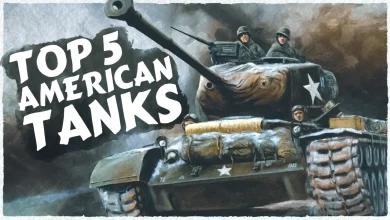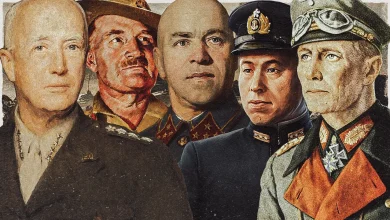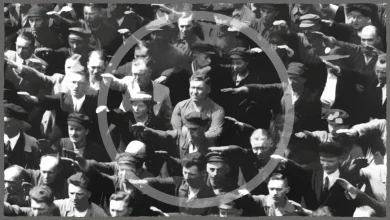Fall of Tobruk 1942
The port city of Tobruk would become the epicenter of the brutal African campaign during World War 2, and it would push the Allies to unimaginable lengths in their attempt to defend it.

In June of 1942, the German forces under the command of General Erwin Rommel were on the run from the British 8th Army. The Allies had recently liberated Tobruk from a famous eight-month siege in which the heroic actions of the 9th Australian maintained the port in Allied hands against overwhelming odds.
As the 8th Army expelled the weakened and depleted Axis forces from eastern Libya, the Allied high command figured it would be impossible for Rommel to launch a counteroffensive anytime soon. Calmly, General Neil Ritchie sent off many of the 8th Army back to Egypt and replaced the remaining troops with inexperienced soldiers.
The miscalculation would prove fatal, as Rommel launched a fierce offensive that overwhelmed the Commonwealth forces. By June 20, Tobruk was again under Axis siege, and the ensuing battle would severely change the course of the war…
A New Theater Appears
Italy was not ready for war as World War 2 erupted over Europe. Knowing this, Benito Mussolini attempted to stay neutral during the conflict’s initial phase.
However, as the fall of France became inescapable, Mussolini realized Britain and France were too busy and too fragile to battle on another front. It was the perfect opportunity for Mussolini to accomplish his life-long dream of expanding into Africa and restoring the Roman Empire under his rule. After the ease in which France had fallen before the Wehrmacht, the Duce was sure Britain and the rest of the Allies would collapse right away.

Mussolini felt Italy was being held back by not having as many colonies and territories as other European nations. If he could take the regions of Gibraltar and the Suez Canal in Egypt from the United Kingdom, it would ensure Italy’s control over the southern coast of the Mediterranean.
Hence, on June 10, 1940, as France clutched at straws and collapsed before the Blitzkrieg, Italy declared war on Britain and France and immediately attempted to invade British-controlled Egypt.
Mussolini’s surprise attack was initially successful. His troops were able to gain a modest territory in Egypt, capturing the port city of Sidi Barrani. The British forces defending Egypt were few and thinly spread across a vast region. Still, what the Western Desert Force army lacked in numbers it made up for inexperience and strategy.

Richard O’Connor, the British commanding officer in the region, used deception and intelligence to get the upper hand on the Italian invaders. After building a defensive perimeter, O’Connor disguised his meager tank numbers by placing inflatable rubber tanks side by side with actual armored vehicles, fooling the Italians into believing they would clash with a massive force. In the face of a seemingly overpowering force, Italy then decided to halt its offensive, giving O’Connor enough time to regroup and plan a counterattack.
Still, O’Connor only had 36,000 men at his disposal, while Italian troops numbered above the 180,000. Using superior strategy and the support of the Royal Air Force, the embattled general struck at the invading forces and drove them out of Egypt. But O’Connor didn’t stop at the border; he continued his campaign into Italian Libya, overpowering an increasingly demoralized Italian army. By January 12, the city port of Tobruk was surrounded, and ten days later, it fell to O’Connor’s forces. 27,000 Italian soldiers were captured along with fuel, supplies, food, and weapons.
In less than two months, O’Connor had trekked over 800 miles, wiped out an entire Italian Army of ten divisions, taken over 130,000 prisoners, 400 tanks, and 1,292 guns at the cost of only 500 casualties and 1,373 wounded. The loss was humiliating and unbearable for Italy, and Hitler was livid.
Afrika Korps
It was the beginning of 1941, and Hitler was frustrated and embarrassed by Italy’s humiliating defeat in Northern Africa. To make matters worse, Mussolini’s reckless attack on Egypt had caused Italy to lose most of Libya along with all its ports, which gave the Allies a significant advantage to supply an eventual liberation of Europe.
Hitler then decided to deploy troops to Northern Africa and help the Italians turn the tables. The man in command of what would be known as the Afrika Korps was a brilliant and experienced general named Erwin Rommel.

After arriving in what was left of Italian-occupied Libya, Rommel conducted an overwhelming surprise offensive, taking advantage of the fact that Commonwealth forces in the area did not expect a counterstrike from the Italians after the colossal defeat they had suffered.

In the following months, Rommel recaptured Libya and forced the Allies back into Egypt. However, an important exception was Tobruk, which had been heavily fortified by the Allied forces. Rommel was forced to lay siege and wait. Inside the city, only one division of mainly Australian soldiers held a legendary defense for over 8 months until December 7, when a reinforced Allied counteroffensive from Egypt codenamed Operation Crusader could break the siege and push Rommel back.

As Rommel had been unable to capture Tobruk, his supply lines extended all the way back to the port of Tripoli 1,000 miles away. With little fuel, food, and ammunition, he was forced to retreat as the Allies freed Tobruk. The valiant efforts of the defenders became a source of pride and a morale booster for all Allied soldiers in the war. But the victory would be short-lived.
A Second Siege
Once again, the Allies assumed the defeated Rommel was weak and depleted and were confident he would take defensive positions back in western Libya. But Rommel would surprise them on January 21, 1942, when he launched another offensive on the startled and unprepared Allies.

Rommel advanced quickly using unrelenting circling maneuvers, and the Allies could only slow him down as they approached Tobruk.
The encounter became a stalemate 60 miles off the city, where the Allied troops created a defensive semicircle of trenches, barb wire, land mines, and tank traps.
Rommel realized that approaching Tobruk from the west would be impossible due to the Allied entrenchment. Thus, on May 27, the Axis forces attempted to undercut them from the south.
The Allies barely held the line in the south, but Rommel was quicker; he rushed back west and successfully encircled the defending troops in the northwest part of the defensive semicircle with the help of Italian forces.

On June 11, the Allies were forced back into the city as their defensive barrier collapsed. The city fell into chaos as the Axis approached, and 8th Army commander Neil Ritchie received conflicting instructions from his superiors.
Military commanders were telling him that his troops should not become trapped in the city under any circumstance, and telegrams from Winston Churchill demanded that Tobruk was not to fall to the Axis advance.
Furthermore, Ritchie was instructed that in the event of the imminent fall of Tobruk, the 8th Army should evacuate, not before destroying all the resources available to them. A nearby airfield, holding tens of thousands of gallons of fuel, plus a significant number of food rations and ammunition crates, were of particular concern to the Allied high command.
Ritchie eventually decided to evacuate as the Axis advance seemed unstoppable, and the 13th and 30th Corps were ordered to retreat to Egypt, leaving only the 2nd South African Division to hold the city.

By June 18, Rommel had surrounded the city, and the Allies had failed to destroy most of the supplies. That night Rommel reported to Hitler that Tobruk was under siege once again.
The Battle
On June 19, Rommel rearranged his troops in preparation for an attack. The battle began at 5:20 am on June 20 with a concentrated air bombardment on the south-eastern boundary, and the Luftwaffe executed 588 raids.
Artillery attacks then commenced at 7:00 am along with the incursion of Gruppe Menny, a battalion with 38 medium tanks. A breach in the line was achieved at 7:45 am, and the German 900th Engineer Battalion bridged over the anti-tank ditch using prefabricated equipment.

The 4th Battalion, Royal Tank Regiment was instructed to counterattack, but the orders arrived too late. When the Allies reached the enemy forces, most tanks had already crossed the ditches. The Afrika Korps then defeated the British armor using “divide and conquer” maneuvers, aided by a relentless attack from Luftwaffe aircraft.
By noon, Rommel had inserted 113 tanks into the perimeter, and just an hour later, the Afrika Korps reached the King’s Cross intersection on the Pilastrino Ridge.
The last barrier for the panzers was an assortment of artillery units that put up a stiff resistance, including the use of several 3.7-inch anti-aircraft guns against the German tanks. Rommel later hailed their: “Extraordinary tenacity.”

By 6:00 pm, the Axis troops were inside the city, and the Allies desperately tried to burn all the supplies they could while also destroying their own communication equipment. Still, most of the Allied units ceased fire or withdrew to Fort Pilastrano to the west only 45 minutes later.
The final evacuation of small Allied ships took place under fire—15 craft escaped, but 25, including a minesweeper, were sunk in the harbor or lost to airstrikes on their way to Alexandria.

At dawn the next day, the Allies officially capitulated. It was the second biggest surrender of British forces as far back as the fall of Singapore, and an estimated 32,200 soldiers were captured and taken into POW camps in Italy.

In addition, Rommel captured a massive number of supplies that the Allies failed to destroy. The defeat became legendary throughout the Western world and severely hurt the morale of the Allied troops in Africa.

Churchill learned about the devastating defeat while meeting at the White House with President Franklin D. Roosevelt. The Prime Minister was in shock, and he would later recall: “I did not attempt to hide from the President the shock I had received. It was a bitter moment. Defeat is one thing; disgrace is another. There were no reproaches; not an unkind word was spoken. ‘What can we do to help?’ said Roosevelt. I replied at once, ‘Give us as many Sherman tanks as you can spare and ship them to the Middle East as quickly as possible.’”
The defeat marked a turning point in the African theater. With fresh supplies, Rommel would become unstoppable for many months and bring Allied troops in Libya and Egypt to the brink of destruction.



